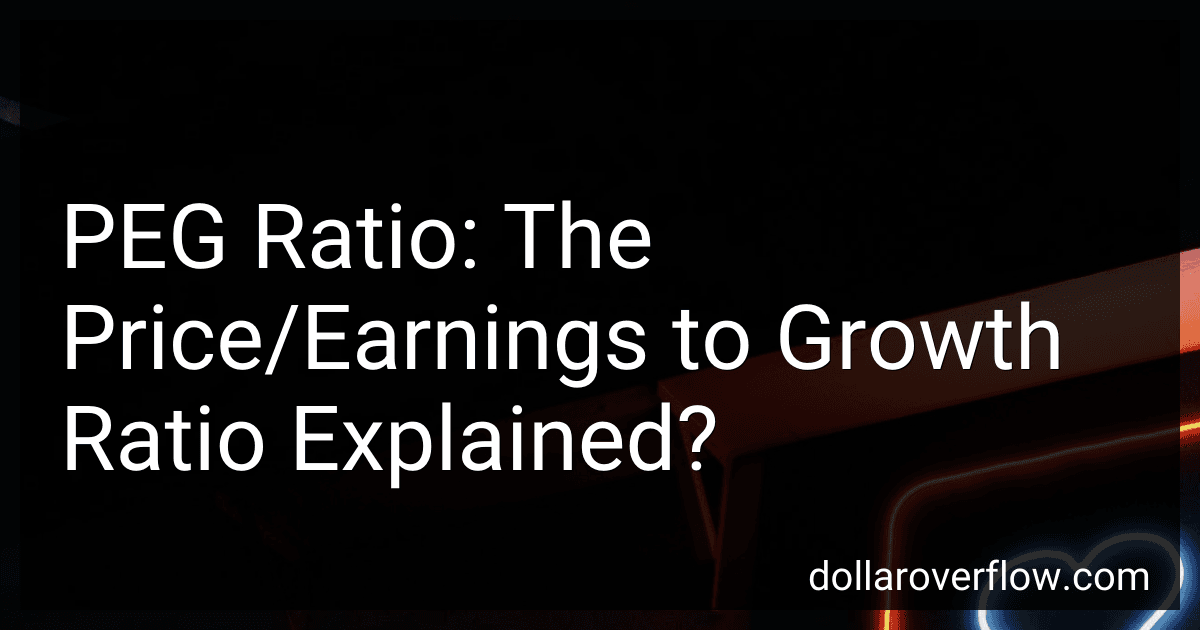The Price/Earnings to Growth (PEG) ratio is a financial metric that investors use to assess the valuation of a company relative to its earnings growth rate. It is calculated by taking the company's Price/Earnings (P/E) ratio and dividing it by the annual earnings per share growth rate.
The PEG ratio provides a more comprehensive picture of a company's valuation compared to just the P/E ratio. A low PEG ratio suggests that a company may be undervalued relative to its earnings growth potential, while a high PEG ratio may indicate that a company is overvalued.
Investors often use the PEG ratio to help them identify potentially undervalued or overvalued stocks when making investment decisions. However, it is important to consider other factors in conjunction with the PEG ratio, such as a company's competitive position, industry outlook, and overall market conditions.
How can companies use the PEG ratio to attract investors?
Companies can use the PEG ratio to attract investors by showing that their stock is undervalued in relation to their expected earnings growth. This can indicate that the company offers a good value for investors, as they are paying less for each unit of expected earnings growth compared to other companies in the same industry. By highlighting a low PEG ratio, companies can demonstrate to investors that they have strong growth potential and are likely to provide a good return on investment. Additionally, companies can use the PEG ratio to differentiate themselves from competitors and position themselves as a more attractive investment option.
What factors can impact the PEG ratio?
- Growth rate: A higher growth rate will result in a lower PEG ratio and vice versa.
- P/E ratio: A higher P/E ratio will result in a higher PEG ratio, while a lower P/E ratio will result in a lower PEG ratio.
- Risk tolerance: Investors with higher risk tolerance may be willing to accept a higher PEG ratio, while those with lower risk tolerance may prefer a lower PEG ratio.
- Industry dynamics: Different industries may have different average PEG ratios, which can impact the evaluation of a company's PEG ratio.
- Market conditions: Market conditions, such as overall economic conditions, interest rates, and geopolitical events, can impact investor sentiment and influence the PEG ratio.
- Analyst estimates: Analyst estimates of future earnings growth can impact the PEG ratio, as it is based on these projections.
- Company-specific factors: Factors such as management quality, competitive positioning, and regulatory environment can impact a company's future growth prospects and, in turn, its PEG ratio.
What does a PEG ratio of 1 mean?
A PEG ratio of 1 means that the stock's price is in line with its expected earnings growth rate. This could indicate that the stock is neither overvalued nor undervalued based on its growth prospects. Investors may see a PEG ratio of 1 as a favorable indicator of a stock's valuation.
How is the PEG ratio different from the P/E ratio?
The PEG ratio, or price-to-earnings growth ratio, is a valuation metric that takes into account a company's earnings growth rate in addition to its P/E ratio. The PEG ratio is calculated by dividing the P/E ratio by the earnings growth rate of the company.
The P/E ratio, or price-to-earnings ratio, is a simple valuation metric that compares a company's stock price to its earnings per share. It is calculated by dividing the stock price by the earnings per share.
The main difference between the two ratios is that the PEG ratio takes into consideration a company's earnings growth rate, providing a more comprehensive view of its valuation compared to the P/E ratio alone. A PEG ratio less than 1 is typically considered favorable, indicating that the stock may be undervalued relative to its earnings growth.
What are the implications of a negative PEG ratio?
A negative PEG ratio can have various implications for investors and analysts, including:
- Undervaluation: A negative PEG ratio may indicate that the company's stock is undervalued relative to its earnings growth potential. Investors may see this as a buying opportunity, as they believe the stock price will increase in the future.
- Growth concerns: A negative PEG ratio could also signal potential financial distress or lack of growth prospects for the company. It may indicate that the company's earnings growth is expected to decline in the future, which could prompt investors to sell their shares.
- Inaccuracy: A negative PEG ratio may be the result of inaccurate or unreliable financial data. Investors should carefully evaluate the company's financial statements and conduct further analysis to confirm the accuracy of the data.
- Market conditions: A negative PEG ratio could be influenced by broader market conditions, such as economic downturns or industry-specific challenges. Investors should consider these factors when interpreting the implications of a negative PEG ratio.
Overall, a negative PEG ratio should be considered in the context of other financial metrics and market conditions to gain a comprehensive understanding of the company's financial health and growth prospects.
